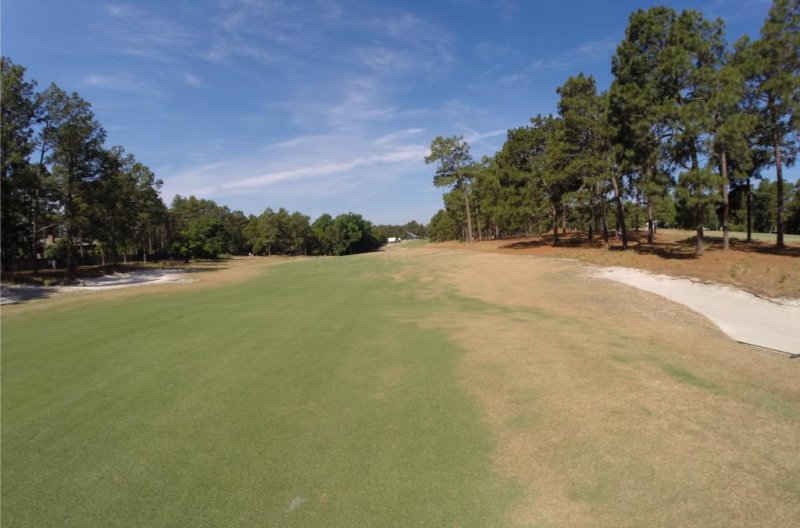1 of 2 |
PINEHURST, N.C., June 13 (UPI) -- There are many modern golf courses in the U.S. touted as links courses. Most of the time, the only thing they have that resembles a links is a lack of trees. There is much more to a "proper" links course, as one would say in Scotland, than having no trees.
Donald Ross and the inspiration behind Pinehurst
Donald Ross grew up walking the "finest linksland" in all Scotland -- the Royal Dornoch Golf Club. Royal Dornoch is one of the lesser-known Meccas of golf, where people played the game as early as the 17th century. Though Dornoch is consistently ranked among the best courses in the world, it stays off the main golf charts thanks to its location -- it's so far north that it hasn't hosted a major championship.
Before Ross went to St. Andrews to study the art of club making under "Old" Tom Morris, he began his golf career at Dornoch as "the keeper of the greens" and as the club's first official golf pro.
Walking around the Dornoch links in his youth profoundly marked Ross. Like a seed dormant until the perfect conditions, Pinehurst lay in wait within Ross' soul.
When he came to Pinehurst, with its sand-based rolling terrain, he found the place for his masterpiece. Ross spent good part of his life nurturing the course, refining as time went on. By the time he was finished, he had created a genuine links course in the sand hills of North Carolina.
As time went by after his death, Ross' masterpiece was Americanized. Pinehurst grew as a resort, so the course began to follow the all-green-everywhere trend, replacing the rough with Bermuda grass. As a result, the true links characteristics of the course were lost -- or at least hidden.
Ben Crenshaw and Bill Coore -- Brown is the New Green
Some time after Ross' death, Ben Crenshaw and Bill Coore had the opportunity to turn back the hands of time. We can't be sure of how much of the Pinehurst we see at the U.S. Opens reflects the course Ross left behind. But one thing is certain: Pinehurst has once again become a proper links course.
Crenshaw and Coore not only saved nearly 40 percent of the cost of watering the course, the two brought back an essential element to links golf -- the color brown. The move is not purely aesthetic -- the brown areas mean more roll on fairway edges and around the green complexes. The end result is that waste areas come into play more quickly off the tee and the playing surface of the greens is reduced. This demands accuracy off the tees and both patience and imagination around the greens.
Playing Golf on the Ground
The other element that the Crenshaw-Coore remake returned to Pinehurst is a game that must be played on the ground.
This will be a big change for many of the American players on tour this week at their national Open. The PGA Tour is mostly played in the air from target to target. There are few targets at Pinehurst; there are only lines and paths, many of them crooked.
Players tried all kinds of shots to get close to the pins during practice rounds. They were particularly troubled around the fabled "turtle-backed" greens, trying each club to find the best way to get back on the greens and close to the hole.
In true links style, the putter was the club of choice. Many tried using their hybrid and fairway woods. Most shots using wedges were sent back to the players' feet or went rolling well beyond the hole. I don't think that any one of them would openly say that they found the answer.
The magic formula for winning at Pinehurst
The outcome of this year's U.S. Open at Pinehurst will be determined by the factors that influence the game from where Donald Ross and the game of golf itself originated. In true links fashion, one needs a fine blend of course knowledge, skill, imagination, patience, the ability to adapt and luck to get the job done.
A good game plan is always needed to win a championship. Setting up a game plan is perhaps the hardest aspect of links golf as it is Mother Nature who ultimately decides how a course is going to play. The sun and heat during the practice rounds made setting up a solid plan seem more like playing roulette.
With the rain that fell last night, players will need to modify their strategy set during the practice rounds. One might think that the sudden softening of the course would automatically make it play easier, allowing for more chances of holding the greens.
This may be true if players find the confidence to play at the flag, as a less-than-perfect shot can still be sent off the green. The uncertainty of how a ball will react upon landing is what makes links golf so difficult to master. The players may have to modify their game plans again over the weekend, as the sandy soil will probably make the course hard and fast again by Sunday.
This is where luck comes into play. As a links golfer, you have to accept luck, hoping that the bad evens out with the good. Being patient if you get a couple of bad breaks and taking advantage of the good is the essence of links golf.
Knowing when a ball just off the green is in the right spot is sometimes better than a ball on the green reflects the maturity that links golf demands. The winner at Pinehurst will need this maturity. More than any other U.S. Open, the winning formula that applies to links golf will prove to be what's needed at Pinehurst.















